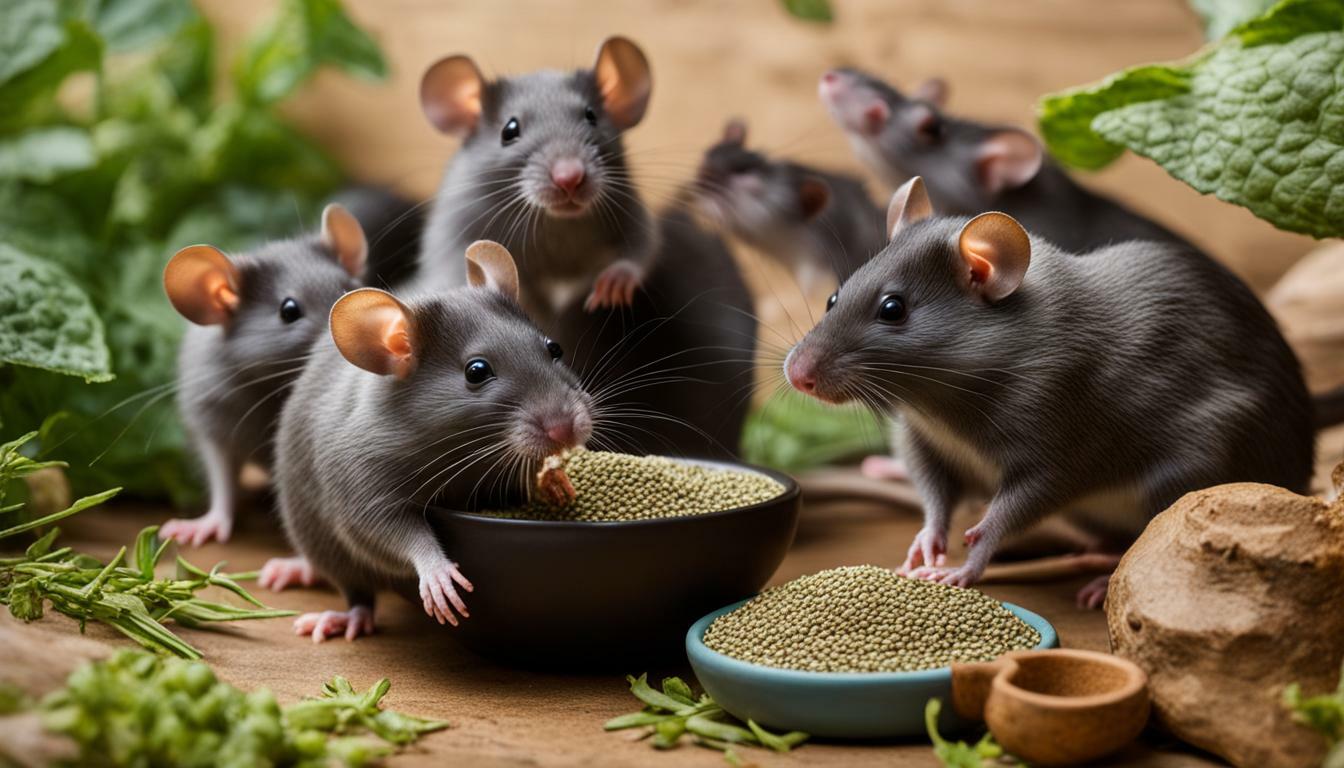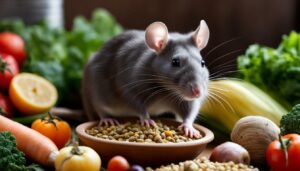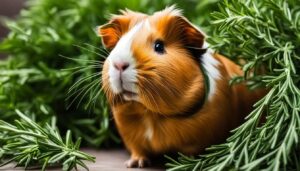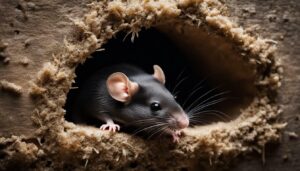If you’re wondering whether chia seeds are suitable for your pet rats, you’ve come to the right place. In this article, we will explore the safety of feeding chia seeds to rats and provide insights into their nutritional value. We’ll also discuss how to incorporate chia seeds into your rats’ diet and the benefits they offer. Additionally, we’ll provide tips on preparing chia seeds for rats, the importance of moderation, and the potential risks of harmful foods and moldy food. Lastly, we will emphasize the significance of a varied diet and treating your rats with care when introducing new foods like chia seeds.
Key Takeaways:
- Rats can safely consume chia seeds when mixed with water to create a gel-like consistency for easier consumption.
- Chia seeds provide rats with essential Omega-3 fatty acids, vitamins, and minerals.
- Chia seeds should not be the sole source of nutrients for rats and should be served as a treat in moderation.
- A balanced diet for rats should include other fruits, vegetables, and their main feed.
- It is important to be cautious about the treats given to pet rats and avoid toxic substances like apple seeds and high-sugar treats.
Incorporating Chia Seeds into a Rat’s Diet
Chia seeds can be a great addition to your rats’ diet, but it’s essential to know how to incorporate them properly. These tiny seeds are packed with nutrition, providing your furry friends with important omega-3 fatty acids, vitamins, and minerals. However, it’s important to remember that chia seeds should not be the sole source of nutrients for your rats. Instead, they should be served as a treat in moderation, alongside a balanced diet that includes other fruits, vegetables, and their main feed.
One of the easiest ways to include chia seeds in your rats’ diet is by turning them into a gel-like consistency. This makes it easier for the rats to consume and digest. To prepare the gel, simply mix one part chia seeds with about four parts water and let it sit for a few minutes until it forms a gel. You can then offer this gel to your rats as a tasty treat. This method ensures that your rats are getting the nutritional benefits of chia seeds without any potential choking hazards.
It’s also worth noting that chia seeds can be incorporated into rat-friendly recipes. For example, you can sprinkle chia seeds on top of their fresh fruits or vegetables, or even mix them into homemade rat treats. The possibilities are endless, allowing you to get creative and provide your rats with a diverse and nutritious diet.
Table 1: Rat-Friendly Chia Seed Recipes
| Recipe | Ingredients | Instructions |
|---|---|---|
| Chia Seed Pudding | Chia seeds, water, fruit puree | 1. Mix chia seeds and water, let it sit for 15 minutes. 2. Stir in fruit puree of your choice. 3. Refrigerate for at least 1 hour before serving. |
| Chia Seed Energy Balls | Chia seeds, rolled oats, nut butter, honey, dried fruit | 1. Combine all ingredients in a bowl. 2. Roll into small balls. 3. Refrigerate for at least 1 hour before serving. |
Remember, when introducing new foods like chia seeds into your rats’ diet, it’s important to do so gradually and observe how they respond. Not all rats may enjoy the taste or texture of chia seeds, so it’s always a good idea to start with small amounts and gradually increase as tolerated. Listen to your rats’ preferences and make adjustments accordingly. With proper incorporation, chia seeds can be a nutritious and enjoyable addition to your rats’ diet, supporting their overall health and well-being.
The Nutritional Benefits of Chia Seeds for Rats
Chia seeds offer a range of nutritional benefits that can positively impact your rat’s overall health and well-being. These small seeds are packed with essential nutrients, including omega-3 fatty acids, vitamins, and minerals.
One of the main benefits of chia seeds for rats is their high omega-3 fatty acid content. Omega-3 fatty acids are important for brain health and can help reduce inflammation in the body. Including chia seeds in your rat’s diet can support their cognitive function and promote a healthy immune system.
In addition to omega-3 fatty acids, chia seeds are rich in vitamins and minerals that contribute to your rat’s overall health. These seeds are a good source of calcium, phosphorus, and magnesium, which are essential for strong bones and teeth. They also contain vitamins A, B, and E, which play a vital role in maintaining a healthy coat, skin, and immune system.
When incorporating chia seeds into your rat’s diet, it’s important to do so in moderation. While they offer many nutritional benefits, chia seeds should not replace a balanced diet that includes a variety of fruits, vegetables, and main feed. Serve chia seeds as a treat or supplement to their regular meals to ensure they receive a well-rounded nutritional intake.
| Nutrient | Amount per 100g |
|---|---|
| Omega-3 fatty acids | 17.8g |
| Calcium | 631mg |
| Phosphorus | 948mg |
| Magnesium | 335mg |
| Vitamin A | 54 IU |
| Vitamin B | 0.1mg |
| Vitamin E | 0.5mg |
Always remember to treat your rats with care when introducing new foods like chia seeds into their diet. Observe their reaction and consult with a veterinarian if you have any concerns about their health or dietary needs. By providing a varied diet that includes chia seeds as a supplement, you can ensure that your rats are receiving the necessary nutrients for optimal health and vitality.
Preparing Chia Seeds for Rats
Making chia seed gel is a simple process that will make it more enjoyable for your rats to munch on this superfood. To prepare chia seeds for your furry friends, you’ll need to follow these easy steps:
- Measure out the desired amount of chia seeds. A good starting point is a teaspoon or two, depending on the number of rats you have.
- Place the seeds in a small bowl or container.
- Add water to the bowl, using a 1:4 ratio of chia seeds to water. For example, if you have one teaspoon of chia seeds, add four teaspoons of water.
- Stir the mixture thoroughly and let it sit for approximately 5-10 minutes. The chia seeds will absorb the water and form a gel-like consistency.
- Once the gel has formed, you can serve it to your rats as a nutritious treat!
By turning chia seeds into a gel, you are providing your rats with a tasty and easily digestible form of this nutrient-rich food. Remember to only offer it to them in moderation, as part of a balanced diet that includes other fruits, vegetables, and main feed.
Chia Seed Gel Recipe
If you’re looking for a specific recipe to try, here’s a simple one to get you started:
Chia Seed Gel for Rats
Ingredients:
- 1 tablespoon of chia seeds
- 4 tablespoons of water
Instructions:
- In a small bowl, combine the chia seeds and water.
- Stir well to ensure the seeds are evenly coated.
- Allow the mixture to sit for about 5-10 minutes, until it thickens into a gel-like consistency.
- Serve a small amount to your rats and watch them enjoy!
| Preparation time | Serving size | Storage |
|---|---|---|
| 5-10 minutes | 1-2 teaspoons | Refrigerate for up to 3 days |
Moderation is Key
While chia seeds offer many benefits, it’s crucial to remember that they should be given to rats in moderation, along with other nutritious foods. Chia seeds can be a great addition to a rat’s diet, providing them with omega-3 fatty acids, vitamins, and minerals. However, it’s important to serve them as a treat and not rely on them as the sole source of nutrients for your furry friend.
When incorporating chia seeds into your rat’s diet, it’s essential to consider their overall nutritional needs. Rats require a balanced diet that includes a variety of fruits, vegetables, and a main feed that is specifically formulated for their nutritional requirements. Chia seeds can be mixed with water to create a gel-like consistency that is easier for rats to consume. This can be a fun treat for them and provides additional hydration.
It’s also crucial to be cautious about the treats you offer your pet rats. While chia seeds are safe for rats to consume, it’s important to avoid toxic substances such as apple seeds and high-sugar treats. These can be harmful to their health and should be avoided. Additionally, moldy food should never be given to rats as it can make them sick and lead to serious health issues.
Remember, variety is key when it comes to your rat’s diet. While chia seeds can offer some nutritional benefits, they should not be the only food source. Make sure to provide a well-rounded diet that includes other fruits, vegetables, and a balanced main feed. By offering a variety of foods, you can ensure that your rats receive the nutrients they need for optimal health and well-being.
| Key Points: |
|---|
| Chia seeds should be given to rats in moderation along with other nutritious foods. |
| Consider your rat’s overall nutritional needs when incorporating chia seeds into their diet. |
| Avoid toxic substances like apple seeds and high-sugar treats when offering treats to your pet rats. |
| Avoid moldy food as it can make rats sick. |
| Offer a well-rounded diet that includes a variety of fruits, vegetables, and a balanced main feed. |
Avoiding Harmful Foods
While chia seeds are safe for rats to consume, it’s crucial to be mindful of other foods that can be harmful to their health. Some common foods that should be avoided when feeding rats include apple seeds and high-sugar treats. Apple seeds contain a substance called amygdalin, which can release cyanide when chewed or consumed in large quantities. This can be toxic to rats and may lead to serious health issues.
In addition to apple seeds, high-sugar treats should also be avoided. Rats have a higher risk of developing dental problems and obesity when consuming sugary foods. It’s important to provide rats with a balanced diet that includes a variety of fruits, vegetables, and main feed to ensure they receive all the necessary nutrients without compromising their health.
Harmful Foods to Avoid:
| Foods | Risk to Rats |
|---|---|
| Apple Seeds | Potential release of cyanide when chewed or consumed in large quantities |
| High-Sugar Treats | Increased risk of dental problems and obesity |
Moldy food should also be avoided when feeding rats. Mold can contain harmful toxins that can make rats sick and lead to digestive issues. It’s important to regularly check and discard any food that shows signs of mold growth to ensure the health and well-being of your pet rats.
By being cautious about the treats given to pet rats and avoiding harmful foods like apple seeds, high-sugar treats, and moldy food, you can help maintain the health and happiness of your furry friends.
Moldy Food and Rat Health
When feeding your rats, it’s important to inspect food for mold to avoid any potential health issues. Moldy food can be harmful to rats and may lead to digestive problems, respiratory issues, and even liver damage. Rats have sensitive digestive systems, and consuming moldy food can pose significant risks to their overall well-being.
To ensure the safety of your rats, always check for signs of mold growth before offering any food. You can easily identify mold by looking for fuzzy or discolored patches on the surface of fruits, vegetables, grains, or other food items. If you notice mold, it’s crucial to discard the entire portion of food to prevent your rats from accidentally ingesting it.
Additionally, it’s essential to store your rats’ food in a cool, dry place to minimize the risk of mold growth. Moisture and warmth create ideal conditions for mold to thrive, so proper storage can help prevent contamination. Regularly clean your rats’ food bowls to remove any leftover food that may attract mold or bacteria.
| Signs of Moldy Food | Prevention Tips |
|---|---|
| Discoloration or spots on the food | Inspect food before feeding |
| Fuzzy or powdery texture on the surface | Store food in a cool, dry place |
| Strong, musty odor | Regularly clean food bowls |
Remember, rats rely on their owners to provide them with a safe and nutritious diet. By carefully checking for moldy food and taking proper storage measures, you can help protect your rats from potential health issues and ensure their overall well-being.
The Importance of Variety
While chia seeds can be a nutritious addition to your rats’ diet, it’s crucial to provide them with a diverse range of foods for optimal health. Chia seeds are rich in Omega-3 fatty acids, vitamins, and minerals that can support your rats’ overall well-being. However, relying solely on chia seeds as the primary source of nutrients for your furry friends may not provide them with the balanced diet they need.
Offering a variety of foods ensures that your rats receive a wide range of nutrients. Alongside chia seeds, you can include other fruits, vegetables, and main feed to create a well-rounded diet for your pets. This variety ensures that they receive the necessary vitamins, minerals, and fiber to support their digestive health, immune system, and overall development.
When introducing new foods to your rats, including chia seeds, it’s important to observe their reactions and adjust accordingly. Some rats may develop preferences, while others may have sensitivities or allergies. By offering a diverse range of foods, you can cater to their individual needs and preferences, providing them with a well-balanced and enjoyable diet.
| Benefits of Variety in Rats’ Diet |
|---|
| Ensures a well-rounded intake of essential nutrients |
| Supports optimal digestive health |
| Provides a diverse range of flavors and textures for your rats to enjoy |
| Helps prevent dietary deficiencies and imbalances |
To summarize, while chia seeds can be a valuable and nutritious addition to your rats’ diet, it’s important to offer them a variety of foods to ensure they receive a balanced intake of essential nutrients. By incorporating chia seeds alongside other fruits, vegetables, and main feed, you can provide your rats with the best possible nutrition and promote their overall health and well-being.
Treating Rats with Care
When incorporating chia seeds into your rats’ diet, it’s essential to introduce them gradually and observe any potential adverse reactions. While rats can safely consume chia seeds, it’s important to remember that they should not be the sole source of nutrients for your furry companions. Chia seeds should be served as a treat in moderation, alongside a balanced diet that includes other fruits, vegetables, and main feed.
As with any new food, it’s crucial to pay attention to how your rats respond to chia seeds. Some rats may have sensitivities or allergies to certain foods, so it’s best to start with a small amount and monitor them closely for any signs of discomfort or digestive issues. If your rats show any adverse reactions, it is advisable to consult with a veterinarian.
Remember that variety is key when it comes to your rats’ diet. While chia seeds offer nutritional benefits such as Omega-3 fatty acids and essential vitamins and minerals, they should be part of a diverse meal plan. Including a range of other safe and nutritious foods will ensure your rats receive a well-rounded diet.
In addition to introducing new foods with caution, it’s also crucial to be mindful of what not to feed your rats. Avoid toxic substances like apple seeds, high-sugar treats, and moldy food, as they can have detrimental effects on your rats’ well-being. It’s your responsibility as a rat owner to treat them with care and prioritize their health when making dietary choices.
Table: Safe and Nutritious Foods for Rats
| Fruits | Vegetables | Main Feed |
|---|---|---|
| Apples (without seeds) | Bell peppers | Rat pellets |
| Blueberries | Broccoli | Oats |
| Strawberries | Cauliflower | Brown rice |
| Bananas | Carrots | Whole grain pasta |
| Grapes | Pumpkin | Quinoa |
By treating your rats with care, introducing chia seeds responsibly, and providing them with a balanced and varied diet, you can ensure their overall health and well-being. Remember, always consult with a veterinarian for personalized advice based on your rats’ specific needs and dietary requirements.
Conclusion
By incorporating chia seeds into your rats’ diet in moderation and alongside a variety of other nutritious foods, you can provide them with an extra boost of beneficial nutrients. As we’ve discussed, chia seeds are safe for rats to eat and offer several nutritional benefits. They contain omega-3 fatty acids, vitamins, and minerals that contribute to overall rat health.
However, it is essential to remember that chia seeds should not be the sole source of nutrients for your rats. They should be served as a treat and be part of a balanced diet that includes a mix of fruits, vegetables, and main feed. Variety is key to ensuring rats receive all the necessary nutrients they need to thrive.
When introducing chia seeds or any new food into your rats’ diet, it’s crucial to treat them with care. Watch for any adverse reactions or digestive issues and consult with a veterinarian if needed. Additionally, be cautious about the treats you offer your rats, avoiding toxic substances like apple seeds and high-sugar treats that can be harmful to their health.
Lastly, it’s important to avoid feeding rats moldy food. Mold can make rats sick and lead to health issues. Always ensure that the food you serve is fresh and free from any signs of mold contamination.
FAQ
Can rats eat chia seeds?
Yes, rats can eat chia seeds. However, they should be mixed with water to make a gel for easier consumption.
What nutritional benefits do chia seeds provide for rats?
Chia seeds offer rats omega-3 fatty acids, as well as essential vitamins and minerals.
How should chia seeds be incorporated into a rat’s diet?
Chia seeds should be served as a treat in moderation, along with other fruits, vegetables, and main feed.
How can chia seeds be prepared for rats?
Chia seeds can be turned into a gel-like consistency by mixing them with water.
Are there any foods that rats should avoid?
Yes, toxic substances like apple seeds and high-sugar treats should be avoided. Moldy food should also be avoided as it can make rats sick.
Should chia seeds be the only source of nutrients for rats?
No, chia seeds should be served as a treat and not the sole source of nutrients. A balanced diet including other fruits, vegetables, and main feed is important for rats.




